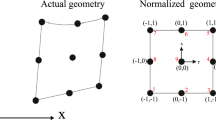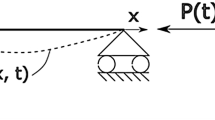Abstract
This paper presents a homogenised finite element formulation for the transient dynamic analysis of asymmetric and symmetric unconstrained layer damping beams in which the viscoelastic material is characterised by a five-parameter fractional derivative model. This formulation is based on the weighted residual method (Galerkin’s approach) providing a fractional matrix equation of motion. The application of Grünwald-Letnikov’s definition of the fractional derivatives allows to solve numerically the fractional equation by means of two different implicit formulations. Numerical examples for a cantilever beam with viscoelastic treatment are presented comparing the response provided by the proposed homogenised formulation with that of Padovan, based on the principle of virtual work. Different damping levels and load cases are analysed, as well as the influence of the truncation and time-step. From the numerical applications it can be concluded that the presented formulation allows to reduce significantly the degrees of freedom and consequently the computational time and storage needs for the transient dynamic analysis of structural systems in which damping treatments have been applied by means of viscoelastic materials characterised by fractional derivative models.
Similar content being viewed by others
References
Jones DIG (2001) Handbook of viscoelastic vibration damping. Wiley, Chichester
Sun CT, Lu YP (1995) Vibration damping of structural elements. Prentice Hall, Englewood Cliffs
Nashif AD, Jones DIG, Henderson JP (1985) Vibration damping. Wiley, New York
Oberst H, Frankenfeld K (1952) Uber die Dampfung Biegeschwingungen Dunner Blech Durch fest Haftende Belage. Acustica 2:181–194
Bagley RL, Torvik PJ (1986) On the fractional calculus model of viscoelastic behaviour. J Rheol 30:133–155
Pritz T (1996) Analysis of four-parameter fractional derivative model of real solid materials. J Sound Vib 195(1):103–115
Pritz T (2002) Five-parameter fractional derivative model for polymeric damping materials. J Sound Vib 265(5):935–952
Podlubny I (1999) Fractional differential equations. Academic, San Diego
Hilfer R (ed) (2000) Applications of fractional calculus in physics. Word Scientific, Singapore
Miller KS, Ross B (1993) An introduction to the fractional calculus and fractional differential equations. Wiley, New York
Oldham KB, Spanier J (1974) An introduction to the fractional calculus and fractional differential equations. Wiley, New York
Cortés F, Elejabarrieta MJ (2006) An approximate numerical method for the complex eigenproblem in systems characterised by a structural damping matrix. J Sound Vib 296(1–2):166–182
Cortés F, Elejabarrieta MJ (2005) Complex modes superposition in non-classically damped systems. In: Proceedings of the 6th international conference on structural dynamics, Paris, France, pp 2171–2176
Padovan J (1987) Computational algorithms for FE formulations involving fractional operators. Comput Mech 2:271– 287
Schmidt A, Gaul L (2002) Finite element formulation of viscoelastic constitutive equations using fractional time derivatives. Nonlinear Dyn 29:37–55
Galucio AC, Deü JF, Ohayon R (2004) Finite element formulation of viscoelastic sandwich beams using fractional derivative operators. Comput Mech 33:282–291
Cortés F, Elejabarrieta MJ (2006) Finite element formulations for transient dynamic analysis in structural systems with viscoelastic treatments containing fractional derivative models. Int J Numer Methods Eng (in press)
Inman DJ (1996) Engineering vibration. Prentice Hall, Englewood Cliffs
Hughes TJR (2000) The finite element method. Dover, New York
Bathe KJ (1996) Finite element procedures. Prentice-Hall, Englewood Cliffs
Zienkiewicz OC, Taylor RL (2000) Finite element method. Butterworth-Heinemann, Oxford
Cortés F, Elejabarrieta MJ (2006) Viscoelastic materials characterisation using seismic response. Mater Des (in press)
Soundown Corporation. http://www.soundown.com
ASTM E 756-04 (2004) Standard test method for measuring vibration-damping properties of materials. American Society for Testing and Material.
Nelder JA, Mead R (1965) A simplex method for function minimization. Comput J 7:308–313
Kosloff D, Frazier GA (1978) Treatment of hourglass patterns in low order finite element codes. Numer Anal Methods Geomech 2:57–72
Author information
Authors and Affiliations
Corresponding author
Rights and permissions
About this article
Cite this article
Cortés, F., Elejabarrieta, M.J. Homogenised finite element for transient dynamic analysis of unconstrained layer damping beams involving fractional derivative models. Comput Mech 40, 313–324 (2007). https://doi.org/10.1007/s00466-006-0101-6
Received:
Accepted:
Published:
Issue Date:
DOI: https://doi.org/10.1007/s00466-006-0101-6




